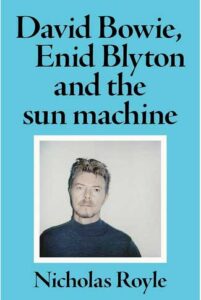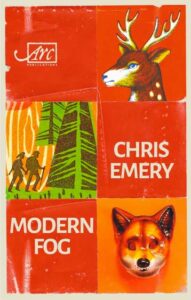

David Bowie, Enid Blyton and the Sun Machine, Nicholas Royle
(Manchester University Press)
Modern Fog, Chris Emery (Arc Publications)
Nicholas Royle’s book is a strange and wonderful book where the author attempts to find common ground, connections, between David Bowie and Enid Blyton, Covid and its effects on family life and his own employment, photography, language, literature, art and music. I only have the book because I made a wrong connection. Despite knowing perfectly well that there are two Nicholas Royles I bought this volume thinking it was by the author I vaguely knew: the novelist, short story and creative non-fiction writer based in Manchester. It isn’t, it is by the other Nicholas Royle, an academic based in Sussex.
It doesn’t matter because it’s one of the best books I’ve ever read. It’s not traditionally academic (in fact I’m not sure it’s even untraditionally academic), rather one that follows networks of possibilities, exploring tangents, asides and even a few dead ends; just the kind of book I like. Turns out both Royles have now left academia, which is another topic that underpins this volume: What is a university for? Why don’t neoliberal governments and management ‘get’ university? How did Covid lockdown become an excuse for university management and politicians to offer redundancies, ‘voluntary severance’ and generally try to get rid of any sense of discussion, debate, discovery and exploration, instead trying to turn degrees into tickbox learning – this plus this equals that; these are the correct ways to do this – rather than encouraging students to think for themselves.
Royle’s book opens with a fictional, seemingly hyper-real, version of the author’s family in lockdown. Dealing with teaching online, home schooling, exhaustion, entertainment and various disappointments and decisions. Mole and Goat, a pair of glove puppets, feature heavily here as characters able to help articulate what’s going on. Mummy’s disappointment at putting a new self-employment on hold, Zeph and Monty’s brotherly discontent and confusion, the author’s decision to take the severance on offer and create a series of eight online lectures as an unasked for farewell gesture.
It is those lectures that make up the middle section of the book, but they are intimately connected to the family’s engagement with Blyton’s Famous Five books and the author’s re-connection with the music of David Bowie. Throughout lockdown, the parents have ended-up reading The Famous Five aloud, sometimes inadvertently from different books in the series, and the boys have also been listening to audio versions of the same or different volumes; and then, each evening, Daddy retreats to the kitchen to sip whisky and listen immersively to his chosen Bowie tracks, cranked up loud.
What the book is really about, of course, is ‘the sun machine’ of the title, which Royle uses as a title for his exploration of how things can transport us, through memory, prompt, daydream and nostalgia, to other places and moments in time. Sometimes that leads to new ideas and new information, other times it reinforces what we already know, sometimes it is salvage work, digging up something we had forgotten or put aside. One of those is a remark by his mother that Royle had forgotten about, that his grandmother had an affair with Enid Blyton; another is how much he remembered of the Blyton books as he read them, and how much Bowie meant to him.
Somehow, Royle’s thesis hangs together, as he meanders through memoir, family history, literature and philosophy. We discover why his father frequented The Croydon Bookshop, often with the young author in tow, yet rarely bought anything, why Shakespeare’s Hamlet evidences time travel, how to misinterpret – and not misinterpret – Freud’s theories of the uncanny, why Polaroids are different to other photographic processes, the etymology of ‘picnic’, and are introduced to the work of Lola Onslow, an illustrator who had an affair with Blyton. Yes, grandmother Royle, who gets a short final section of the book to herself, following a return to the lockdown household.
That’s not the end though. There’s also an Afterword by Peter Boxall, who appears to be an Oxford academic and a Visiting Lecturer at Sussex University, who has written a kind of lengthy blurb, a mini-essay if you like, that praises but also attempts to legitimise what we have just read. He notes that the book itself is a kind of sun machine, one that transports the reader elsewhere, into possibilities and potentials; a book which ‘belongs to a small but noble family of works whose effects rest on the blurred distinction between what they are “about”, and what they “are”.’ He concludes that ‘Royle’s book produces new relations between literature and philosophy, between thinking and imagining, between listening and seeing’, which seems fair enough to me, but rather spoils it all by suggesting it is ‘a free festival that generates a new kind of imaginative possibility’ and hyperbolically declaiming that the book ‘projects a visionary university, in which literature, painting and music live on, sustained by nothing other than the light and warmth of the sun.’
Trying to explain Royle’s book in this way, attempting to somehow push it into a more established genre or framework, or even a utopian vision, undermines it for me. The book’s ambiguity and unexpected connections are what makes it so original and exciting to read. There’s been a spate of this kind of critical add-ons recently, and they’re really not needed. Boxall’s piece would be much more interesting as a stand-alone review or essay. Anyway, as I noted earlier, it’s one of the best and most original books I’ve ever read.
The connections Chris Emery makes in his poems between medieval churches, Norfolk, landscape, pilgrimage, nature, creativity and perceptions are as wide-ranging as Royle’s, if not, perhaps, as unexpected. After all, poetry always works by allusion, omission, metaphor and language’s musicality. And Emery’s connections are often ones I understand, perhaps even share, having taught sailing in Norfolk each summer and easter back in the 70s and 80s, having written about place and family. Modern Fog is surprisingly clear to me: a world of pilgrimage, architecture, history and subdued spirituality, one leavened by melancholy, family and love.
Emery, however, writes very differently from me. His poetry is gently lyrical, often making use of subtle rhymes and controlled metre. He situates himself, or his narrator, within the world and responds to it. At times there is a specific domesticity here, poems about what is revealed by the contents of ‘The Memory Box’, strangers and relatives, romance and commitment, the turning of the seasons, rituals and observances.
‘Pentecost’ offers a subdued take on the descent of the Holy Spirit. Here, it is a pigeon flying home to its dovecot, and there are no tongues of fire, only a feeling of cold to be alleviated by a projected return indoors ‘to stir the grates, / to light all the fires.’ Elsewhere a fox’s corpse, seen over a period of time, decays and changes, ignored it seems by everyone except the narrator:
He was pathetically shiny
and under-featured in the wet waste where
it seemed cruel nothing had feasted on him.
He was slowly withdrawing from us
nothing to clear the debris of him, the world
relaxed into him with all its fiery prayers.
[Day Fox’]
It is this attention to what is seen, alongside a sense of what is unseen, that marks Emery’s poetry out. Is ‘The Start Of It’ simply about Spring, time passing or something more dramatic? The poem starts by gently addressing the reader: ‘But there will come a time you’ll surely know it’, a time of distraction, where ‘something abstract stiffens in the grace of it’. The word ‘grace’ here and ‘rapture’ earlier in the poem gives a nod to the spiritual, makes me think that not only is the narrator marking the moment when we start thinking about our mortality, what we have and haven’t done or achieved, but also making sure we understand that in due course we will
see the formal shape of things you make in time,
the here and there of sweet things and bitter things
we all carry silently – and that will be the start of it.
It is this silence, what is left unsaid, the numinous and unknown, that underpins the work gathered together in Modern Fog. Central to the book is ‘At St Helen’s, Ranworth’, a poem in twelve parts, that uses a visit to ‘the cathedral of the Norfolk Broads’ as the basis for riffs on Norfolk, where ‘The mildew and mint air saps’ as ‘the silent River Ant drift[s] through / a world all emerald and silver’; tourism, relocation and how a place can become home; how history is evidenced by ‘vague […] mustered fragments’; the spiritual as revealed by nature, medieval buildings, decay and human love. Everything, in fact, that lurks ‘Somewhere in the moon mind’ of the poet.
Modern Fog embraces that ‘moon mind’, does not attempt to clear away the mist and fog, instead embracing it as a way of seeing, as a source of potential illumination and reimagination of the world around us. Emery somewhat disingenuously claims to only ‘remember what we all remember’, but he does not. He pays attention, notices, responds, is busy
hanging on
to make sense of it all
as the sap runs out.
[‘The Day Storm’]
Like Royle, Emery is adept at taking unexpected twists and turns, surprising and delighting us as, despite his chosen route, he somehow always leads us back home.
Rupert Loydell
.
